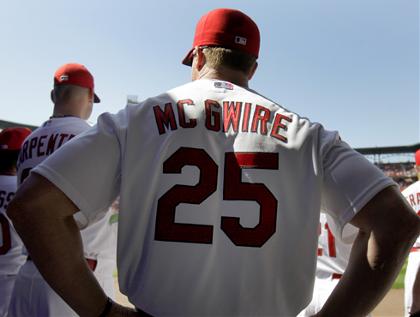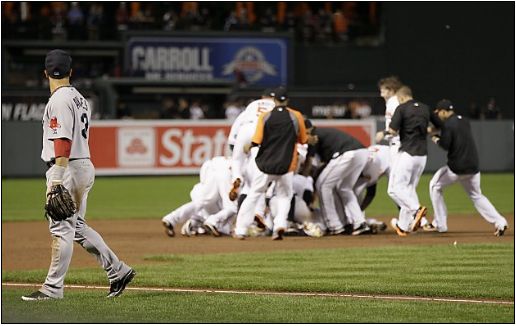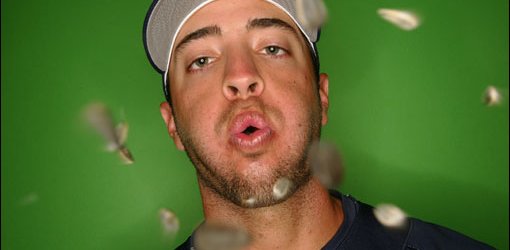 On a gorgeous Monday afternoon in St. Louis, the Houston Astros strode into Busch Stadium to take on the Cardinals in their home opener. Amidst a record crowd, Adam Wainwright sat down the Astros in a tidy 2 hours and 24 minutes. Albert Pujols homered (again) and Ryan Ludwick had four hits. Of course, against the hapless Astros, this is hardly a surprise. Nevertheless, the biggest story of the day took place before the game during introductions, when a crowd approaching 50,000 fans gave a standing ovation to former Cardinal great and current hitting coach Mark McGwire.
On a gorgeous Monday afternoon in St. Louis, the Houston Astros strode into Busch Stadium to take on the Cardinals in their home opener. Amidst a record crowd, Adam Wainwright sat down the Astros in a tidy 2 hours and 24 minutes. Albert Pujols homered (again) and Ryan Ludwick had four hits. Of course, against the hapless Astros, this is hardly a surprise. Nevertheless, the biggest story of the day took place before the game during introductions, when a crowd approaching 50,000 fans gave a standing ovation to former Cardinal great and current hitting coach Mark McGwire.
Writers theorized about how McGwire finally earned forgiveness for his past PED trangressions — a forgiveness undoubtedly made easier on the conscience of so many Cardinal fans who are aware of the team’s prolific 2010 offense (five runs per game). I couldn’t agree less.
I see the “message” as not being meant for McGwire at all, but rather a statement to the whining pontificators bemoaning an entire era in baseball history. The fans realize that the same blowhards that have been condemning McGwire since St. Patty’s Day 2005 were also the ones using column space to write love letters to him and Sammy Sosa in 1998 — and they are sick of it. Fans have grieved over players like McGwire, but they’ve moved on. For those members of the media and ex-players who are still calling for erased record books, it is time to do the same (as a side note, broadcaster and former deadbeat Jack Clark, who called McGwire a “phony,” was summarily booed by the home crowd).
Mark McGwire's record-breaking 1998 season was the epitome of late 1990's-early 2000's culture. By 2005, those days were long gone and McGwire was in exile.
Since Ken Caminiti came clean in 2002, baseball hasn’t been the same. Defense, fielding and walks are in. Homeruns are out. There aren’t a lot of guys walking around that look like McGwire, Sosa or Barry Bonds. Which all and all, is probably a good thing. You can argue that it’s more exciting to see a guy like Nick Johnson grind his way to a .400 on-base percentage rather than a 50 HR season from Brady Anderson, but either way, you’re not looking at the same product anymore. The economics of this game, hell, of this country, dictated a new type of dynamic that has broken down the long-standing beliefs that were accepted as undeniable baseball insider fact. The old tale that a veteran’s grit is worth more than an equally-talented 20 year-old earning the league minimum is an extinct ideology. The war against Sabermetrics is over, and as much as Joe Morgan hates to admit it, the old guard lost. The fact that Zach Greinke and Tim Lincecum won a combined 31 games last year and still captured their respective league’s Cy Young awards proves that the revolution is here. Think I’m wrong? Check out the last night’s box score.
So while baseball may not be better than it was in 1998 or 2001, it’s not worse. And the game has survived. Revenues are up and so is attendance. Blame Mark McGwire and Barry Bonds all you want, but nothing they ingested during their careers is going to knock the luster off of the emergence of new superstars like Evan Longoria or Justin Upton. It’s time for the writers to move on. For those who love the sport, it’s time to put the dream-like period of baseball history that has become known as the “Steroid Era” into perspective: what an incredible (yet tainted) era of baseball. There is no reason we should turn our backs on it, or the icons who made box-score watching fun again.
Speaking of box-scores: the last time St. Louis had a shutout during a home opener was 1998 when they beat the Dodgers 6-0. Guess who led the way? McGwire, who hit a grand slam.








